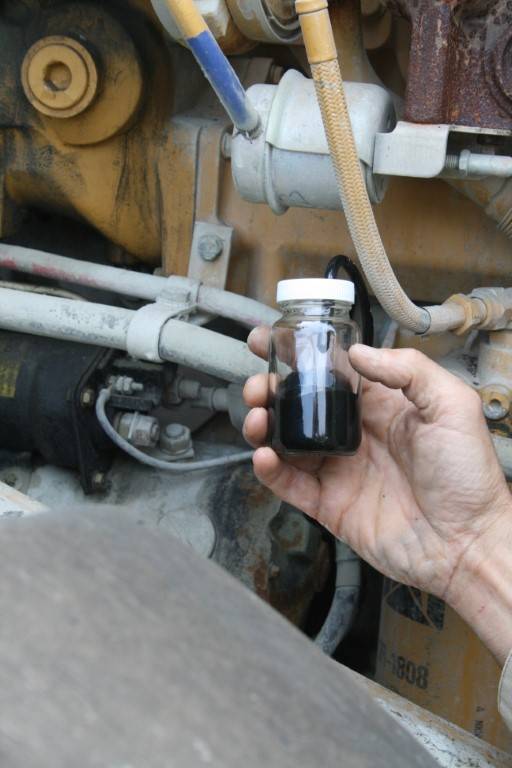There is a more recent version of the info about oil sampling available!
Why take oil samples from heavy used machinery?
Analyzing the oils used in construction machinery can be useful to get information about wear from the contents of the used oil. An analysis of the existing oils only makes sense if you have an approximate idea of how long the oil was in use. If the oil has only recently been changed, an analysis of the condition is not very useful. There are then too few analyzable particles in the oil. If the oil used is much older than permitted, i.e. the change intervals have been significantly exceeded, the values will also be incorrect. But if the oil is in a normal change cycle, you can read a lot of information from the trace elements. It is therefore important to know whether the prescribed maintenance intervals on the construction machine have been observed.

How to take an oil sample from heavy used machinery?
For meaningful results, it is necessary to warm up the machine first. Otherwise there will be many particles deposited on the bottom of the oil pan or in the filter. The oil must therefore be vigorously moved and the viscosity increased in order to obtain meaningful results. Then use a very clean container and a pump to remove the oil, e.g. from the engine/the hydraulic circuit or from the gearbox. The extracted oils need to be sent to a certified laboratory. There, the lubricants are analyzed for their ingredients using various methods. It can be used to determine whether there are increased levels of silicon, sulphur, copper, coolant or other trace elements in the oil.
What can I read from the results?
A professional laboratory for the analysis of construction machine oils usually provides us with an interpretation of the analyzed values. Too much silicon means dirt gets into the machine’s systems and you have to look at where and how dirt gets into the system. If coolant is found in the engine oil, there is a problem in the cooling system. If traces of aluminum are found in the transmission oil, one can conclude that there is increased wear in some components. The same applies to the presence of chromium, copper or magnesium.
Mevas offers oil sampling as additional service during inspections. As soon as we have the results of an oil analysis, our technicians will advise you and describe the possible causes. A hint is given on what to do to avoid early problems. Do you have any questions? Contact us today.
What is an oil analysis useful for on excavators and wheel loaders?
Oil analysis, also known as fluid analysis or lubricant analysis, is a valuable diagnostic tool used in the maintenance and management of excavators and wheel loaders, as well as other heavy equipment. Here are some of the key benefits and purposes of oil analysis for these machines:
- Condition Monitoring: Oil analysis provides a way to monitor the overall condition of the equipment. By analyzing oil samples regularly, maintenance personnel can detect early signs of wear, contamination, and potential issues, allowing for proactive maintenance.
- Component Health Assessment: Oil analysis can reveal the health of critical components such as engines, hydraulic systems, and transmissions. It can help identify wear and tear on internal parts like bearings, gears, and seals.
- Early Problem Detection: Detecting problems at an early stage can prevent costly breakdowns and major repairs. Oil analysis can identify issues such as abnormal wear, contamination, and fluid degradation before they lead to major failures.
- Fluid Quality Assessment: It assesses the quality and condition of the lubricating oils, hydraulic fluids, and other fluids used in the machine. This information helps ensure that the fluids are within the manufacturer’s specifications, promoting optimal performance.
- Contamination Detection: Oil analysis can identify the presence of contaminants, such as dirt, water, and other foreign materials in the lubricants. Contaminants can cause damage and reduce the efficiency of critical components.
- Fluid Change Intervals: By monitoring the condition of the oils and fluids, equipment operators can determine the optimal time to change or replace them, reducing unnecessary maintenance costs.
- Extended Component Life: Effective oil analysis and timely maintenance can extend the life of key components, such as engines, hydraulic systems, and transmissions, resulting in cost savings over the long term.
- Performance Optimization: Oil analysis can help ensure that the machine operates at its peak performance by maintaining clean, properly lubricated components.
- Environmental Impact Reduction: Proper maintenance, guided by oil analysis, reduces the risk of fluid leaks and component failures, minimizing the environmental impact of equipment operation.
- Cost Savings: Regular oil analysis can lead to cost savings through reduced downtime, lower repair and replacement costs, and improved equipment reliability.
- Warranty Compliance: For equipment under warranty, oil analysis can help ensure that maintenance practices comply with the manufacturer’s requirements, preserving warranty coverage.
In summary, oil analysis is a valuable tool for excavators and wheel loaders, as it aids in the early detection of problems, extends the life of components, optimizes performance, reduces maintenance costs, and contributes to efficient equipment management. It is an essential part of a comprehensive maintenance and reliability program for heavy equipment. On a MEVAS TA-2 inspection an oil analysis is always included.

